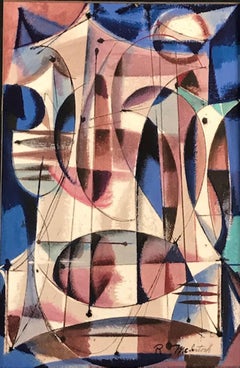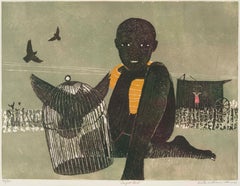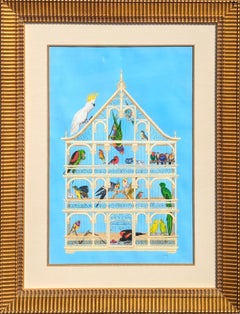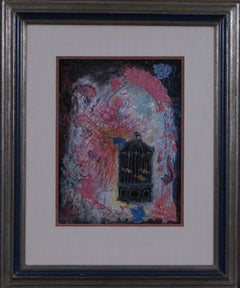Items Similar to Bird in Cage
Want more images or videos?
Request additional images or videos from the seller
1 of 7
John AthertonBird in Cageabout 1940
about 1940
$65,000
£49,278.93
€56,805.57
CA$91,542.07
A$101,513.39
CHF 53,337.75
MX$1,240,321.04
NOK 667,328.06
SEK 626,401.41
DKK 424,064.75
About the Item
Gouache on board, 20 x 24 in.
Signed (at lower right): Atherton
Painted about 1940
RECORDED: Art News (May 11, 1940), illus. [clipping citation]
EXHIBITED: The Art Institute of Chicago, 1940, The International Watercolor Exhibition, no. 156, illus. on cover as Bird in Cage
EX COLL.: the artist; to private collection, as gift; by descent, until 2000
Born in Brainerd, Minnesota, John Atherton was an accomplished painter and illustrator whose fanciful, and highly original, compositions made him a significant figure in the American Surrealist movement (sometimes referred to as “Magic Realism”) of the 1930s and ’40s. After serving in the Navy during World War I, he began his career on the West Coast, studying at the College of the Pacific, in Stockton, California, and the California School of Fine Arts, in San Francisco. A $500 first prize at the annual exhibition of the Bohemian Club, in 1929, financed his move to New York, and he ultimately settled in Ridgefield, Connecticut. Much of Atherton’s early success came as an illustrator, and, in addition to his advertisement designs for General Motors and Shell Oil, his work graced the covers of such popular publications as Fortune and The Saturday Evening Post. Throughout the 1940s, Atherton was an active exhibitor at most of the major art institutions, including The Art Institute of Chicago; the Pennsylvania Academy of the Fine Arts, Philadelphia; The Corcoran Gallery of Art, Washington, D. C.; the Carnegie Institute, Pittsburgh; the Whitney Museum of American Art, New York; and the National Academy of Design, New York. He was also involved in a number of important exhibitions extolling Surrealism in America, including Dorothy C. Miller’s and Alfred H. Barr’s American Realists and Magic Realists at The Museum of Modern Art, New York, in 1943.
Atherton was represented by the Julien Levy Gallery, New York, a driving force behind the Surrealist movement in this country. The great modernist interest in dreams and the subconscious arrived in the United States from Europe in the early 1930s, but it was not until the end of the decade that the radical movement found wide acceptance here. The influential migration to America of such Surrealist luminaries as André Breton, Salvador Dali, Max Ernst, and Yves Tanguy began at the onset of World War II in 1939, approximately the same period Atherton painted the present picture.To even the most casual viewer, Bird in Cage seems fraught with symbolism. The large bird awkwardly trapped in an ornate cage is a hauntingly enigmatic image whose meaning we are instantly tempted to dissect. In Renaissance painting the caged bird was among the most popular iconographic symbols of female purity, but it was usually a domesticated bird. By confining what is clearly a wild water fowl of some sort, the artist may be referring to the human race’s often negative impact on the natural environment. When coupled with the desolation of the encroaching fog (or snow) bank, one might think of the devastating connotations associated with World War II. Importantly, however, while critics and admirers noted the intellectualism of Atherton’s paintings, the artist himself argued his compositions were ruled primarily by emotion. He once explained:
If my pictures are thought intellectual, so be it, but I believe they are so only in that when an emotion is responsible for certain results the intervening processes which go to make the emotion felt may be intellectual ones. In the end the painting must be felt, not analyzed (Dorothy C. Miller and Alfred H. Barr, Jr., eds., American Realists and Magic Realists, exhib. cat. [New York: The Museum of Modern Art, 1943], p. 26).
With this in mind, it may suffice to conclude that Atherton juxtaposed such odd and disconcerting images simply to convey the feeling of profound anxiety, isolation, and uncertainty brought on by the Depression and World War II. The closed-in house, clean, impersonal lines, and stark lighting seem to heighten the tension and uneasiness. True to his intentions, the meaning of Atherton’s works may always prove elusive, but the underlying emotion never fails to strike a chord with the viewer. Bird in Cage also exhibits Atherton’s impeccable sense of composition, which he honed during his many commissions for magazine covers. By employing a variety of horizontals, verticals, and diagonals he has created a carefully controlled and ordered scene. This enables him to express a great deal in a single, simple image, one which manages to convey intimacy, breadth, and depth at the same time.
Atherton was an avid fisherman and member of the Anglers Club of New York. He died at the age of fifty-two while on a salmon-fishing trip in New Brunswick, Canada. Atherton’s work is represented in numerous public collections, including The Metropolitan Museum of Art, New York; the Whitney Museum of American Art, New York; The Museum of Modern Art, New York; The Art Institute of Chicago; the Pennsylvania Academy of the Fine Arts, Philadelphia; and the Wadsworth Atheneum, Hartford, Connecticut
- Creator:John Atherton (1899 - 1972, American)
- Creation Year:about 1940
- Dimensions:Height: 27.25 in (69.22 cm)Width: 32.5 in (82.55 cm)
- Medium:
- Movement & Style:
- Period:
- Condition:
- Gallery Location:New York, NY
- Reference Number:Seller: APG 82391stDibs: LU2310062232
About the Seller
5.0
Recognized Seller
These prestigious sellers are industry leaders and represent the highest echelon for item quality and design.
Established in 1952
1stDibs seller since 2010
35 sales on 1stDibs
Typical response time: 3 hours
Associations
Art Dealers Association of America
- ShippingRetrieving quote...Shipping from: New York, NY
- Return Policy
Authenticity Guarantee
In the unlikely event there’s an issue with an item’s authenticity, contact us within 1 year for a full refund. DetailsMoney-Back Guarantee
If your item is not as described, is damaged in transit, or does not arrive, contact us within 7 days for a full refund. Details24-Hour Cancellation
You have a 24-hour grace period in which to reconsider your purchase, with no questions asked.Vetted Professional Sellers
Our world-class sellers must adhere to strict standards for service and quality, maintaining the integrity of our listings.Price-Match Guarantee
If you find that a seller listed the same item for a lower price elsewhere, we’ll match it.Trusted Global Delivery
Our best-in-class carrier network provides specialized shipping options worldwide, including custom delivery.More From This Seller
View AllUntitled
By Charles Houghton Howard
Located in New York, NY
Charles Houghton Howard was born in Montclair, New Jersey, the third of five children in a cultured and educated family with roots going back to the Massachusetts Bay colony. His father, John Galen Howard, was an architect who had trained at M.I.T. and the École des Beaux-Arts in Paris and apprenticed in Boston with Henry Hobson Richardson. In New York, the elder Howard worked for McKim, Mead and White before establishing a successful private practice. Mary Robertson Bradbury Howard, Charles’s mother, had studied art before her marriage. John Galen Howard moved his household to California in 1902 to assume the position of supervising architect of the new University of California campus at Berkeley and to serve as Professor of Architecture and the first Dean of the School of Architecture (established in 1903). The four Howard boys grew up to be artists and all married artists, leaving a combined family legacy of art making in the San Francisco Bay area that endures to this day, most notably in design, murals, and reliefs at the Coit Tower and in buildings on the Berkeley campus.
Charles Howard graduated from the University of California at Berkeley in 1921 as a journalism major and pursued graduate studies in English at Harvard and Columbia Universities before embarking on a two-year trip to Europe. Howard went to Europe as a would-be writer. But a near-religious experience, seeing a picture by Giorgione in a remote town outside of Venice, proved a life-altering epiphany. In his own words, “I cut the tour at once and hurried immediately back to Paris, to begin painting. I have been painting whenever I could ever since” (Charles Howard, “What Concerns Me,” Magazine of Art 39 [February 1946], p. 63). Giorgione’s achievement, in utilizing a structured and rational visual language of art to convey high emotion on canvas, instantly convinced Howard that painting, and not literature, offered the best vehicle to express what he wanted to say. Howard returned to the United States in 1925, confirmed in his intent to become an artist.
Howard settled in New York and supported himself as a painter in the decorating workshop of Louis Bouché and Rudolph Guertler, where he specialized in mural painting. Devoting spare time to his own work, he lived in Greenwich Village and immersed himself in the downtown avant-garde cultural milieu. The late 1920s and early 1930s were the years of Howard’s art apprenticeship. He never pursued formal art instruction, but his keen eye, depth of feeling, and intense commitment to the process of art making, allowed him to assimilate elements of painting intuitively from the wide variety of art that interested him. He found inspiration in the modernist movements of the day, both for their adherence to abstract formal qualities and for the cosmopolitan, international nature of the movements themselves. Influenced deeply by Surrealism, Howard was part of a group of American and European Surrealists clustered around Julien Levy. Levy opened his eponymously-named gallery in 1931, and rose to fame in January 1932, when he organized and hosted Surrealisme, the first ever exhibition of Surrealism in America, which included one work by Howard. Levy remained the preeminent force in advocating for Surrealism in America until he closed his gallery in 1949. Howard’s association with Levy in the early 1930s confirms the artist’s place among the avant-garde community in New York at that time.
In 1933, Howard left New York for London. It is likely that among the factors that led to the move were Howard’s desire to be a part of an international art community, as well as his marriage to English artist, Madge Knight...
Category
20th Century American Modern Abstract Drawings and Watercolors
Materials
Paper, Gouache, Graphite
Excavation
By Charles Houghton Howard
Located in New York, NY
Charles Houghton Howard was born in Montclair, New Jersey, the third of five children in a cultured and educated family with roots going back to the Massachusetts Bay colony. His father, John Galen Howard, was an architect who had trained at M.I.T. and the École des Beaux Arts in Paris, and apprenticed in Boston with H. H. Richardson. In New York, the elder Howard worked for McKim, Mead and White before establishing a successful private practice. Mary Robertson Bradbury, Charles’s mother, had studied art before her marriage. John Galen Howard moved his household to California in 1902 to assume the position of supervising architect of the new University of California campus at Berkeley and to serve as Professor of Architecture and the first Dean of the School of Architecture (established in 1903). The four Howard boys grew up to be artists and all married artists, leaving a combined family legacy of art making in the San Francisco Bay area that endures to this day, most notably in design, murals and reliefs at the Coit Tower and in buildings on the Berkeley campus.
Charles Howard graduated from the University of California at Berkeley in 1921 as a journalism major, and pursued graduate studies in English at Harvard and Columbia Universities before embarking on a two-year trip to Europe. Howard went to Europe as a would-be writer. But a near-religious experience, seeing a picture by Giorgione in a remote town outside of Venice, proved a life-altering epiphany. In his own words, “I cut the tour at once and hurried immediately back to Paris, to begin painting. I have been painting whenever I could ever since” (Charles Howard, “What Concerns Me,” Magazine of Art 39, no. 2 [February 1946], p. 63). Giorgione’s achievement, in utilizing a structured and rational visual language of art to convey high emotion on canvas, instantly convinced Howard that painting, and not literature, offered the best vehicle to express what he wanted to say. Howard returned to the United States in 1925, confirmed in his intent to become an artist.
Howard settled in New York and supported himself as a painter in the decorating workshop of Louis Bouché and Rudolph Guertler, where he specialized in mural painting. Devoting spare time to his own work, he lived in Greenwich Village and immersed himself in the downtown avant-garde cultural milieu. The late 1920s and early 1930s were the years of Howard’s art apprenticeship. He never pursued formal art instruction, but his keen eye, depth of feeling, and intense commitment to the process of art making, allowed him to assimilate elements of painting intuitively from the wide variety of art that interested him. He found inspiration in the modernist movements of the day, both for their adherence to abstract formal qualities and for the cosmopolitan, international nature of the movements themselves. Influenced deeply by Surrealism, Howard was part of a group of American and European Surrealists clustered around Julien Levy. Levy opened his eponymously-named gallery in 1931, and rose to fame in January 1932, when he organized and hosted Surrealisme, the first ever exhibition of Surrealism in America, which included one work by Howard. Levy remained the preeminent force in advocating for Surrealism in America until he closed his gallery in 1949. Howard’s association with Levy in the early 1930s confirms the artist’s place among the avant-garde community in New York at that time.
In 1933, Howard left New York for London. It is likely that among the factors that led to the move were Howard’s desire to be a part of an international art community, as well as his marriage to English artist, Madge Knight...
Category
20th Century American Modern Abstract Paintings
Materials
Canvas, Oil
Untitled [Abstraction]
By George L.K. Morris
Located in New York, NY
Gouache on paper, 18 7/8 x 14 3/4 in.
Signed (at lower right): Morris; (with monogram, on the back): GLKM [monogram] / 1932 [sic]
Executed circa late 1940s
A passionate advocate of abstract art during the 1930s and 1940s, George L. K. Morris was active as a painter, sculptor, editor, and critic. An erudite man with an internationalist point of view, Morris
eschewed the social, political, and figural concerns that preoccupied so many artists of Depression-era America, believing that painters should focus their attention on the beauty, refinement, and simplicity of pure form instead. His goal, he said, was “to wedge the expression further and further into the confines of the canvas until every shape takes on a spatial meaning” (as quoted in Ward Jackson, “George L. K. Morris: Forty Years of Abstract Art,” Art Journal 32 [Winter 1972–73], p. 150).
Born into an affluent family in New York City, Morris was a descendent of General Lewis Morris, a
signer of the Declaration of Independence. From 1918 until 1924, he attended the Groton School in
Connecticut, studying classics and art. He continued to focus on literature and art while attending
Yale University (1924–28), an experience that prepared him well for his future activity as an artist-critic. After graduating in 1928, Morris studied at the Art Students League of New York, working
under the realist painters John Sloan and Kenneth Hayes Miller, as well as Jan Matulka, the only
modernist on the faculty. In the spring of 1929, Morris traveled to Paris with Albert E. Gallatin, a
family friend and fellow painter who introduced him to leading members of the Parisian avant-garde, including Jean Arp, Pablo Picasso, Georges Braque, Jean Hélion, and Piet Mondrian. Morris also took classes at the Académie Moderne, studying under Fernand Léger and Amédée Ozenfant, important exponents of Synthetic Cubism who influenced his aesthetic development. Indeed, after experimenting with the simplified forms of Modernism for a few years, Morris moved on to abstraction by 1934, adopting a hard-edged, geometric approach inspired by Leger’s cubist style and the biomorphic shapes of Arp and Joan Miró.
Following his return to New York in 1930, Morris built a white-walled, open-spaced studio (inspired
by that of Ozenfant, which had been designed by Le Corbusier) on the grounds of Brockhurst, his
parents’ 46-acre estate in Lenox, Massachusetts. In 1935, he married the painter and collagist Estelle “Suzy...
Category
1940s American Modern Abstract Paintings
Materials
Paper, Gouache
Prop
By Randall Exon
Located in New York, NY
Oil on canvas
Category
2010s Contemporary Landscape Paintings
Materials
Oil, Canvas
$20,000
Sixth Hour
By John Moore
Located in New York, NY
Signed and dated (at lower right): MOORE '19
Category
2010s Contemporary Paintings
Materials
Canvas, Oil
$40,000
September
By Randall Exon
Located in New York, NY
Oil on panel
Category
2010s Contemporary Landscape Paintings
Materials
Oil, Panel
$18,000
You May Also Like
The Birdcage
By Robert McIntosh
Located in West Hollywood, CA
Robert McIntosh(1916-2010), was a prolific American artist that worked and exhibited throughout his life in California. In 1948, McIntosh was awarded first prize at the Los Angeles County Museum of Art, and again ion 1949 at the San Francisco Museum of Art.
"The Birdcage...
Category
1950s Modern Animal Paintings
Materials
Oil
CAGED BIRD
By Walter Henry Williams
Located in Portland, ME
Williams, Walter Henry (American 1920-1998). CAGED BIRD. Color woodcut, 1966. Edition of 210, signed, dated, titled and numbered 43/210 in pencil. 18 x 24 i...
Category
1960s Figurative Prints
Materials
Woodcut
“Bird Cage” Contemporary Blue Toned Surreal Still Life Painting of Various Birds
Located in Houston, TX
Contemporary naturalistic painting by Texas-based artist Jennifer Lively. The work features groups of various species of birds all in a single cage set against a light blue backgroun...
Category
2010s Contemporary Animal Paintings
Materials
Watercolor
Tapestry
By Freeman Baldridge
Located in Storrs, CT
Freeman Baldridge's depiction of "Tapestry," mixed media comprised of paint with fabric. Sight size measures 11 1/2 x 8 1/2; board measures 17 1/8 x...
Category
20th Century Modern Landscape Paintings
Materials
Mixed Media
The cage bird will dream of clouds Timothy Archer Contemporary art blue painting
By Timothy Archer
Located in Paris, FR
Oil painting and pastel on paper
Unique work
Hand-signed by the artist
Category
2010s Contemporary Animal Paintings
Materials
Paper, Pastel, Oil
Maitland Smith Decorative Painting of Birds in a Cage
By Maitland Smith
Located in Hopewell, NJ
Handsome oil on board still life painting of birds in a decorative birdcage with beautiful gilded frame.
Board 24” W x 20” H.
Category
1990s North American Decorative Art
Materials
Canvas
More Ways To Browse
Wood Birds Vintage
Mid Century Bird Paintings
John Andre
Vintage Bird Panels
1940s Landscape Painting California
John Cage
Bird On A Cage
Large Ornate Wood Frame
Bohemian Club
Vintage Bird Pictures
Canadian Landscape Artists Early 20th Century
1930s Paintings Birds
Andre Birds
Wood Fisherman
John Ernst
Large Vertical Landscape Oil Paintings
Stockton Artist
Bird Cage Painting
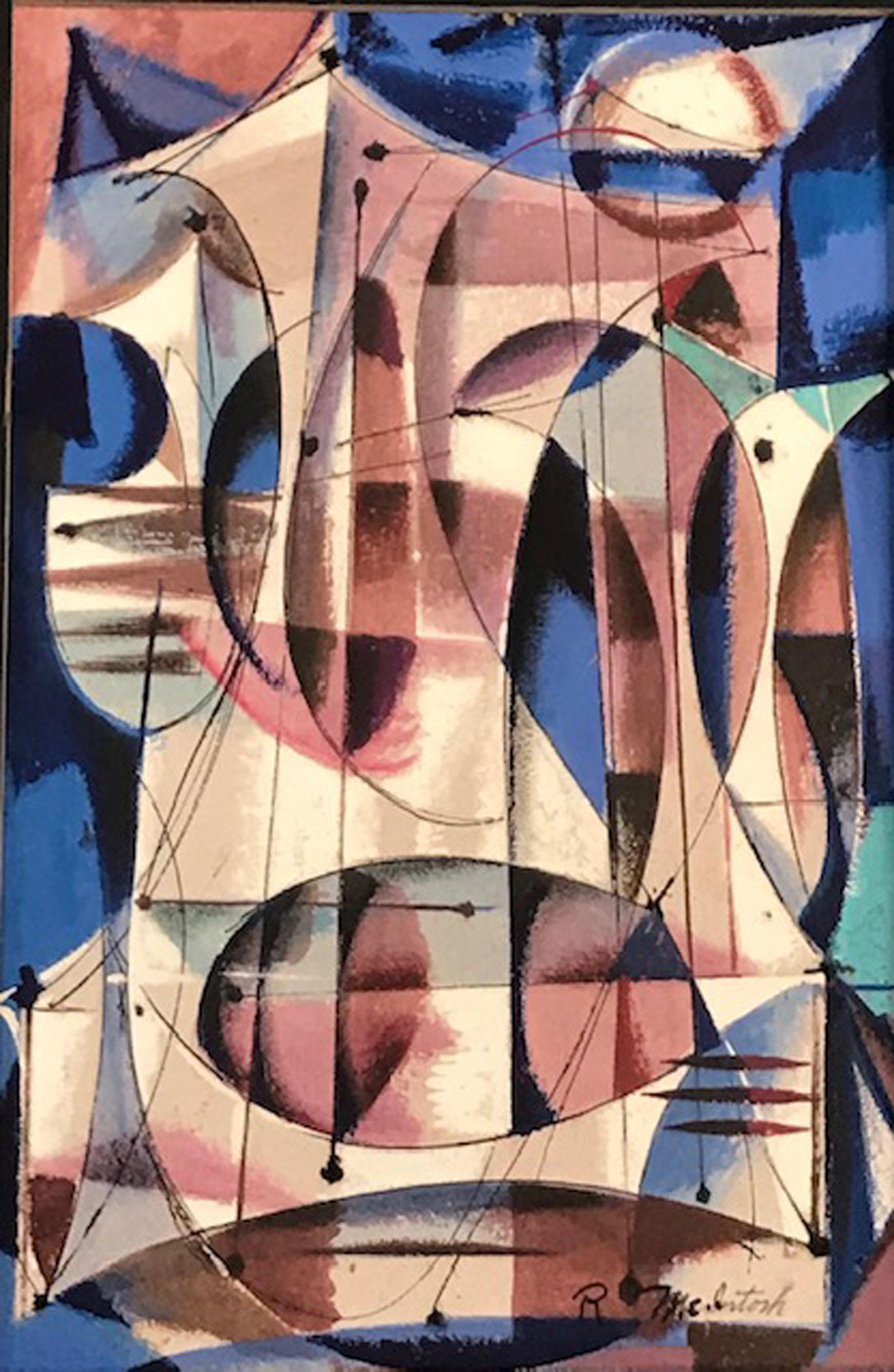
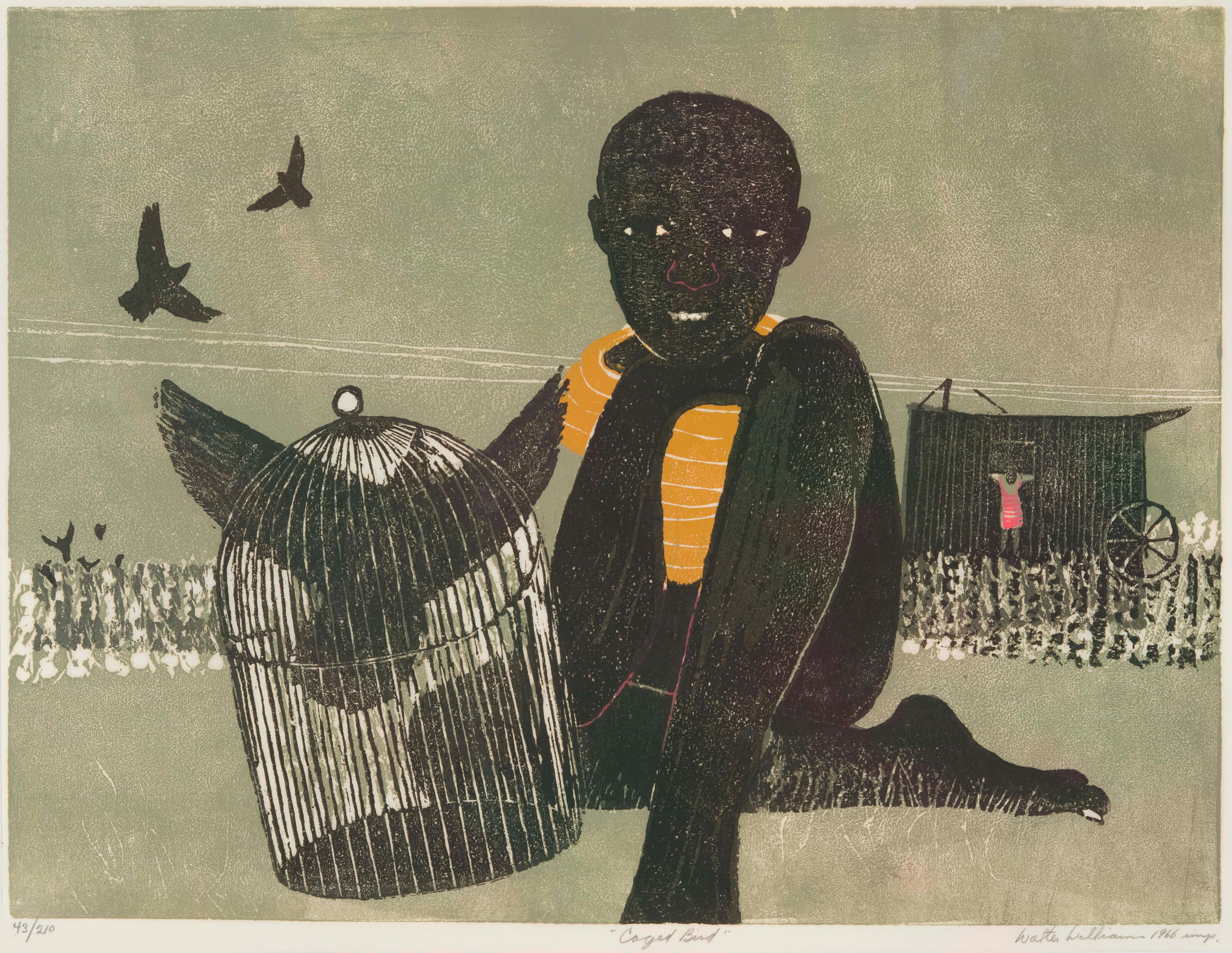
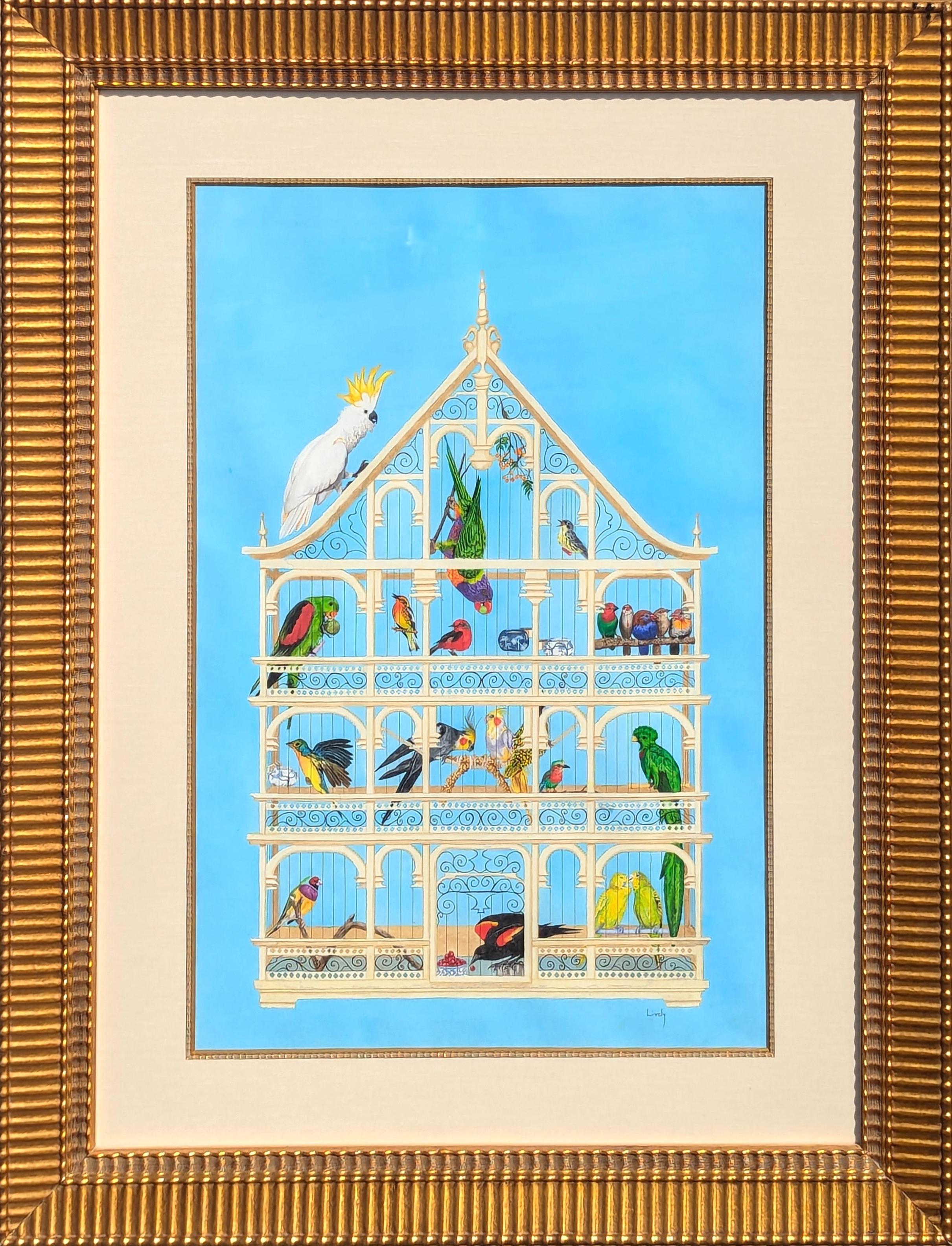
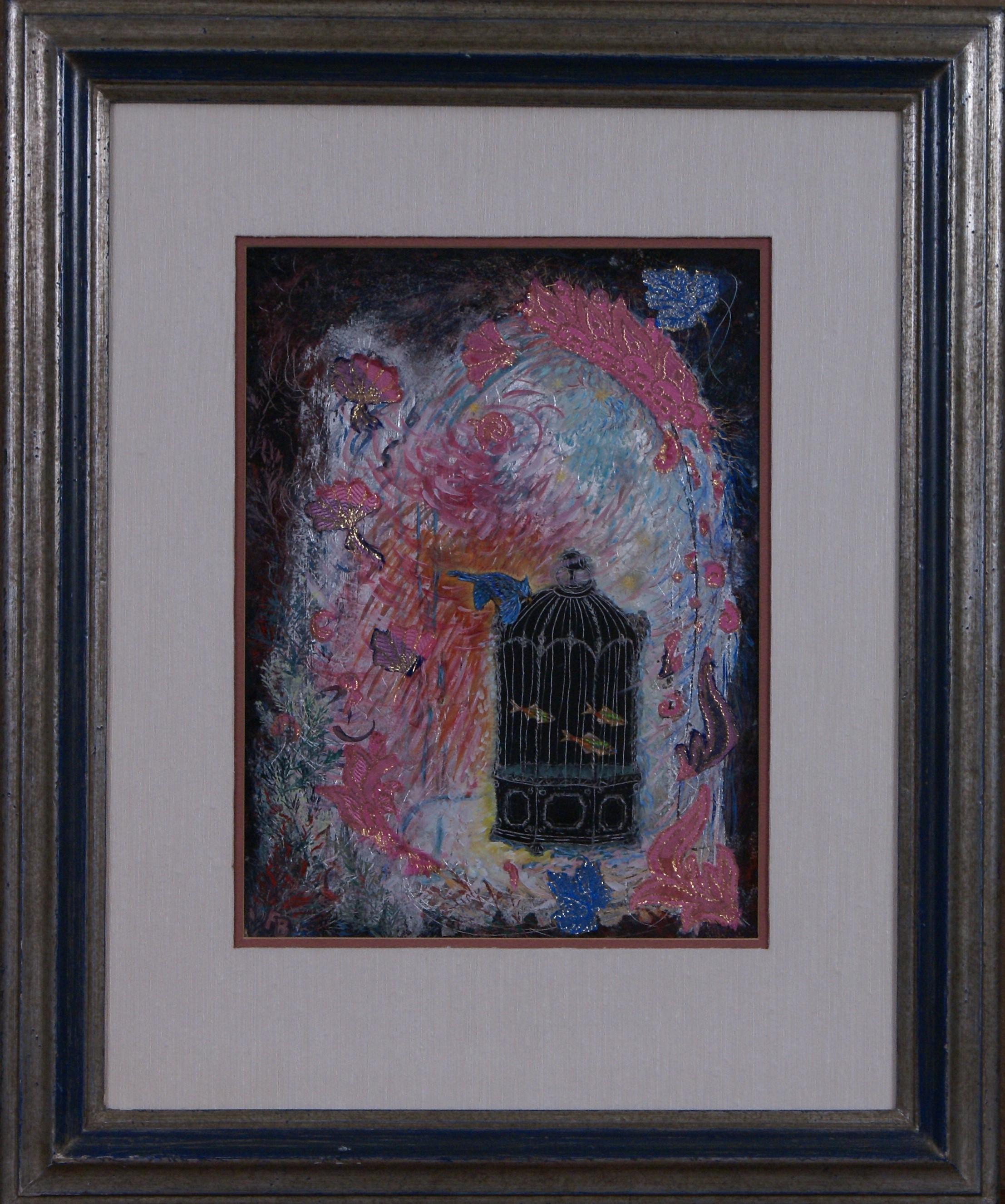
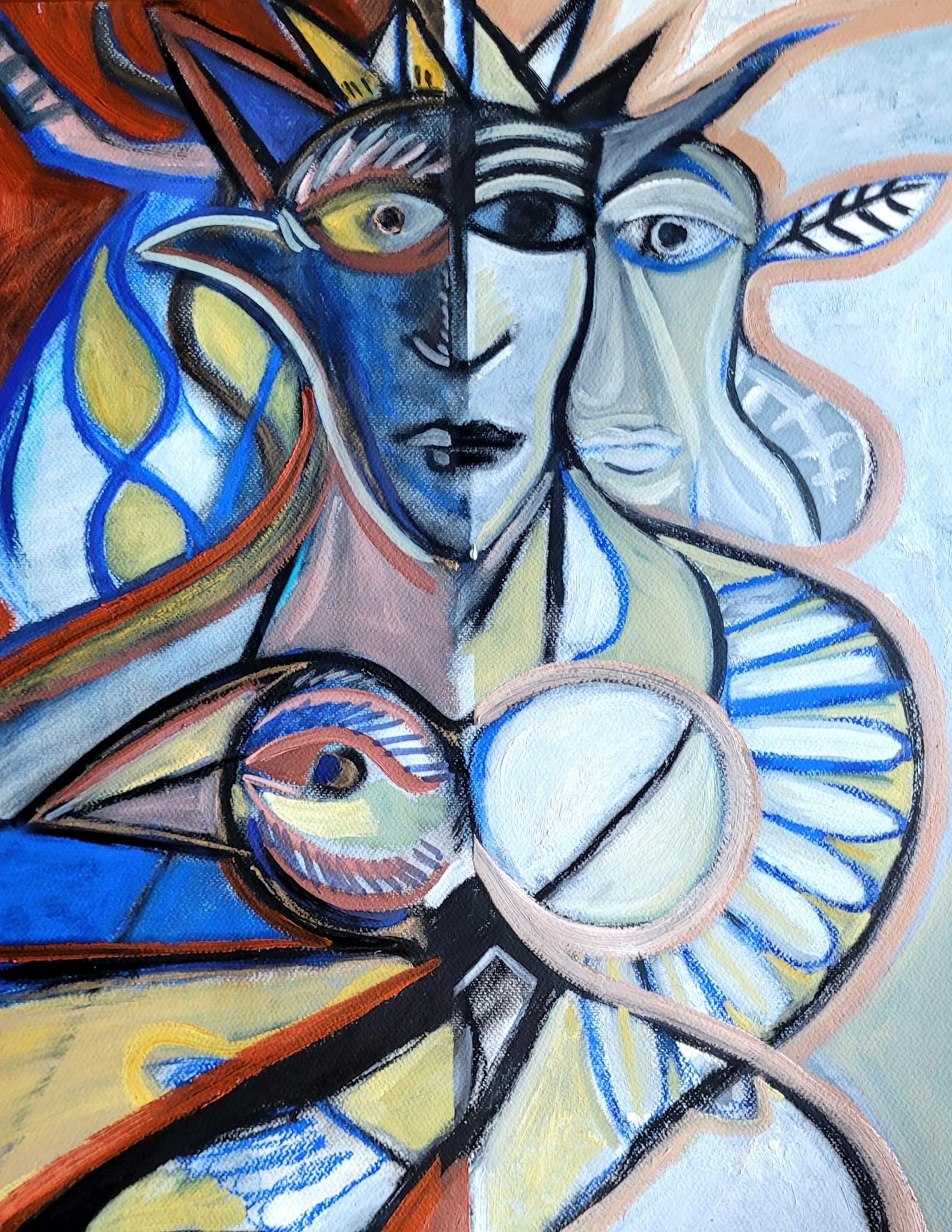
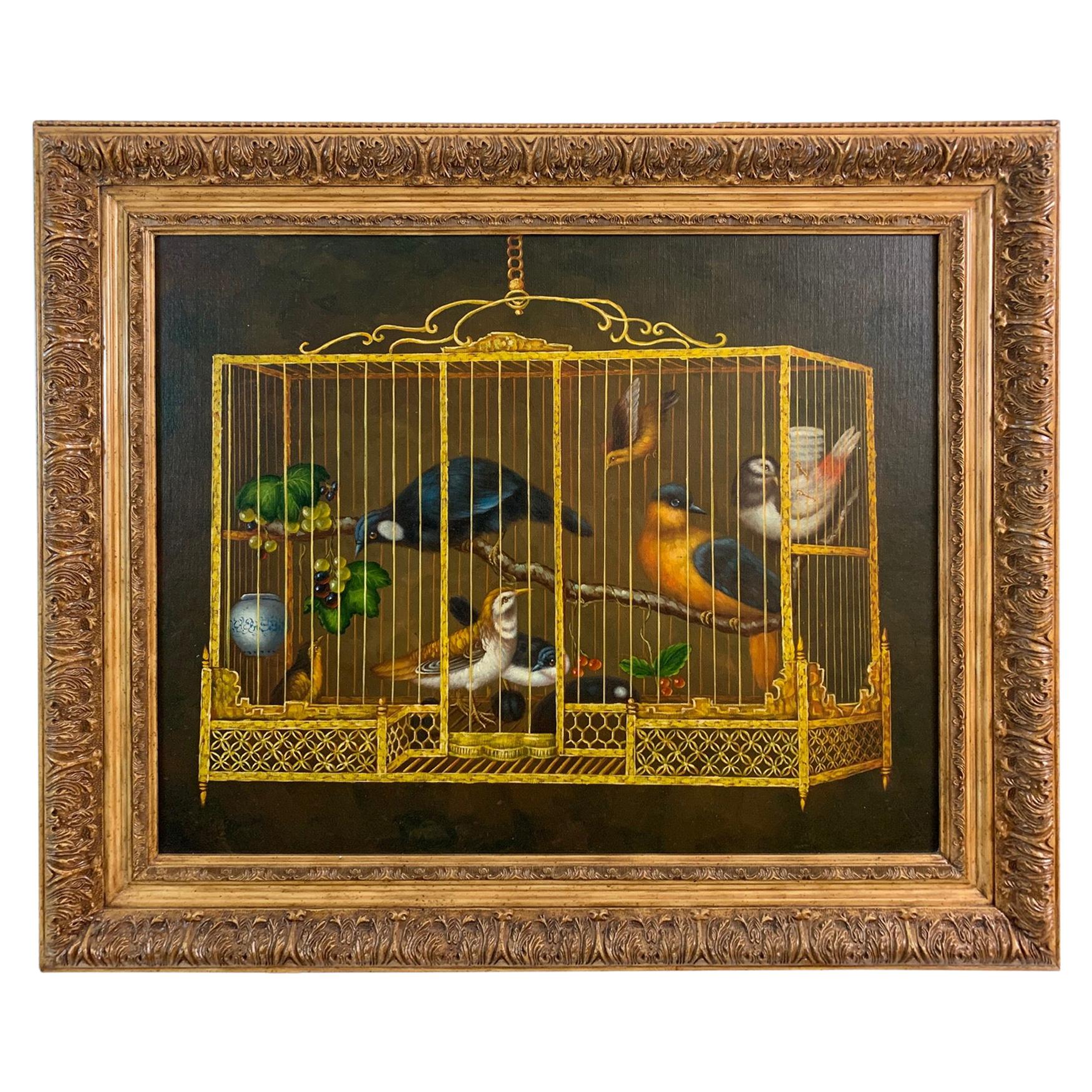
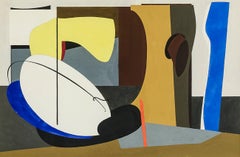
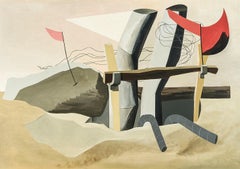
![Untitled [Abstraction]](https://a.1stdibscdn.com/george-lk-morris-1905-1975-american-paintings-untitled-abstraction-for-sale/a_23/1652214284908/APG_8941_unfr_master.jpg?width=240)

